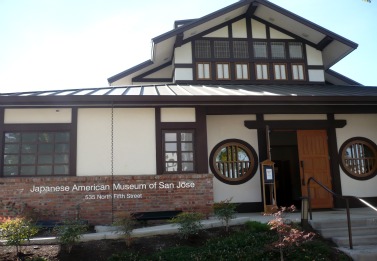 Japanese American Museum of San Jose impresses with photographs and artwork
Japanese American Museum of San Jose impresses with photographs and artwork
Japanese American Museum of San Jose. The museum, which opened on Oct. 16, houses the memories of various Japanese Americans who were incarcerated during World War II. Photo by Hazel Hyon.
When we picture the American flappers of the 1920s, we think of bobbed hair, pleated skirts, the iconic hat—and Caucasian faces. How can flappers be anything but white?
It turns out that some flappers were Asian—Japanese, in fact. In the Japanese American Museum of San Jose, a framed photograph from 1926 shows a group of Asians standing in front of a “typical bachelor house.” The men wear crisp, dapper suits, and the women standard flapper outfits, ready to start dancing.
A source of shocking revelations about racial boundaries, concentration camps, and the worlds that fell apart with incarceration, the Japanese American Museum of San Jose preserves the past of which the American government has long been ashamed. Even those who know or care nothing about Japanese American culture will emerge from the museum with a deeper understanding of American immigrants and the consequences of racism.
Located in the heart of San Jose’s 120-year-old Japantown, JAMsj was first founded in 1987 but reopened after two years of reconstruction on Oct. 16. The building is a breathtakingly beautiful model of a traditional Japanese farmhouse, with tidy geometric accents that create a symmetric design. Though quite small, the museum maintains a cozy atmosphere, a perfect complement to the emotional content that guests experience through visual representations of history.
 Though there are a few artifacts scattered throughout the museum, the main pieces showcased in JAMsj focus on Japanese American internment during World War II and are of two types: journalistic photographs and artwork created by Japanese Americans.
Though there are a few artifacts scattered throughout the museum, the main pieces showcased in JAMsj focus on Japanese American internment during World War II and are of two types: journalistic photographs and artwork created by Japanese Americans.
The photographs range from the late 19th century to post-internment and state what the fearful government refused to believe—that these people were as American as apple pie. There are pictures of people attending their high school proms, not much different from those of MVHS save their outdated hairstyles, and a picture of a woman with her college roommates in Ohio. Despite their ethnic backgrounds, the photographs show that they were fully immersed in American culture.
And yet the immigrants were ruthlessly collected and thrown into cold, cramped barracks in a hysterical fit of xenophobia. The exhibit of Chizuko Judy Sugita de Queiroz, an artist who uses watercolors to express the various experiences she had as a nine-year-old prisoner in Arizona, lies in a corner of the room somewhat isolated from the rest of the museum. Reminiscent of impressionism, the paintings are bold slashes of bright colors that provide form to memories de Queiroz had of “the loneliest place of the most desolate feelings.” One particular piece, titled “Unanswered Prayers,” depicts shadowy figures of people in a dark room with a barred window; the angry streaks of black and yellow seem to spill off the canvas in a flood of emotion. It is difficult not to feel sympathy and frustration while viewing the artwork—the pain of the Japanese Americans was real and raw.
While much smaller than the nearby Rosicrucian Egyptian Museum, the admission cost for JAMsj is less expensive, at $3 for students and $5 for general adults. Also surrounded by numerous Japanese restaurants and specialty stores, the museum is truly worth a visit for those who are seeking to spend a meaningful hour or two on a Saturday afternoon.
{cc-by-sa}





